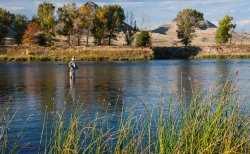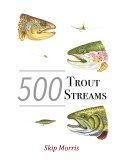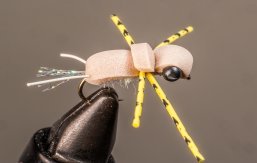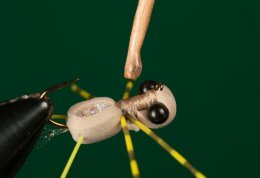Third Thursday Flies
11. Parmachene Belle
with Skip Morris
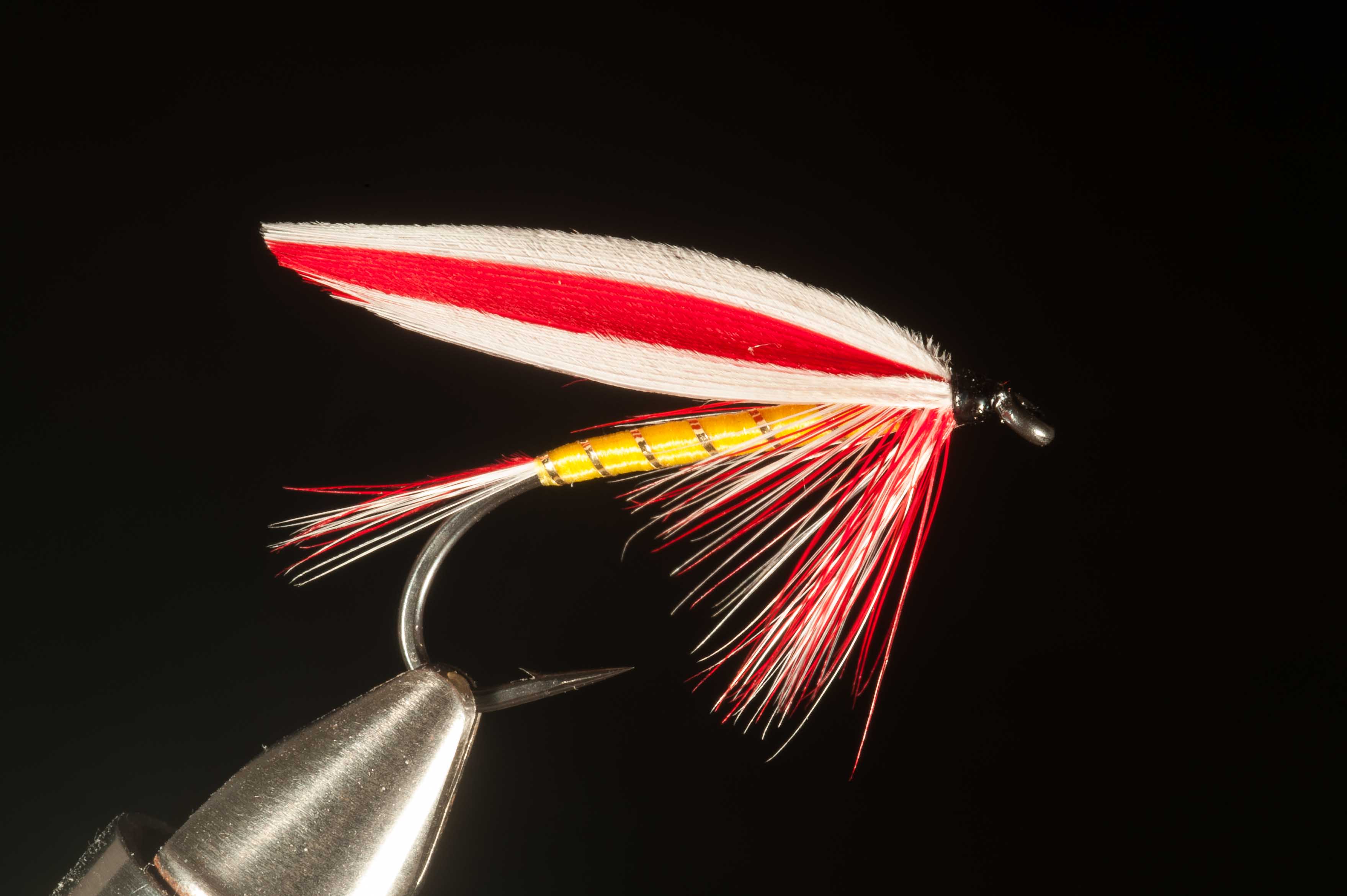 Parmachene Belle
Parmachene Belle
(Photo © Carol Ann Morris)
In this realm of existence, on this planet, at this point in aquatic vertebrate/invertebrate evolution, there is surely nothing living in fresh water that remotely resembles the bright and ornate Parmachene Belle wet fly. It'll be genetic engineering run amok if ever anything does. But that just makes the Parmachene an "attractor" pattern, right? One intentionally designed to be unnatural. Fly fishers suffer no shortage of attractor flies.
The Parmachene Belle is arguably as lovely as any of the many traditional wet-fly patterns. ("Belle" meaning "a pretty or the prettiest girl"; "Parmachene" for Parmachene Lake in Maine, odd because the fly has surely been fished mostly in streams.) Its beauty is why it seems a shame the Parmachene gets tied and fished so seldom now. It's colorful—red and white, shining gold and yellow. It's got all the classic wet-fly parts—swept-back hackles, a tail, a body of floss under a rib (though other bodies and no rib are common in wet flies too), and low, cupped wings. And the Parmachene Belle has that effect on the human eye, one of the many varieties of this effect, that makes flies sell. What's the problem?
The problem is, in part, that today the wet fly is seen by many fly fishers in the same way they see the coal-burning steam-driven locomotive: as obsolete. What stubbornly remains almost a secret is that the old wet can be as effective now on our caught, released, and careful trout as it was back when trout missed all the training and went straight to the dinner plate. And the traditional wet can, in fact, serve as a perfectly viable insect imitation. But perception matters, and thus the wet is currently tied, fished, and appreciated by only a relative few. (If you believe the wet fly has outlived its value, watch Davy Wotton's video "Wet Fly Ways," and expect to see the old wet from a very new perspective.)
Wet flies imitate a good number of important mayflies and caddisflies, those mayflies and caddis that spend time, as part of their natural life cycle, underwater as winged adults. Sounds nuts, but is true, and not at all uncommon. (Check your fly-fishers' entomology books if you doubt it.) Then there are the drowned winged adult insects, small stoneflies, mayflies, caddis . . . Wets imitate those too.
That paragraph presents a sound argument for imitative wet flies. But the Parmachene, imitating nothing and needing to imitate nothing, gets its validation from that same wellspring that validates all attractors: it catches fish.
Fly companies seem to avoid wet flies in general and flies like the Parmachene Belle in particular, and they probably avoid the Parmachene in particular because of the fly's married wings. To "marry," join together, sections cut from duck or goose primary feathers takes some fuss. You hold the sections edge to edge, work them gently until their microscopic zipper-like system fully kicks in—the same interlocking system that holds together the whole blade of the feather from which they came. For the Parmachene Belle you marry a white section with a red one, then another white one with the other side of the red so that you have the appearance of a red band down the center of a white wing. This is the twenty-first century—who has time for that? Not most of the fly companies, because they ask, "Who'll pay for the time it takes our tiers to marry feather sections?" And they're right: few fly fishers will pay, especially for a type of fly they consider outdated.
But if you're a tier yourself, maybe you do have the time. Constructed with reasonable skill, the fly you make will reward your investment of fifteen to twenty minutes at the vise with the sight of an elegant Parmachene Belle. Then, if you fish it with reasonable skill, you can watch the fly slip across the current just inches down and see a trout nose appear and snatch it.
Parmachene Belle Henry Wells
- HOOK: Heavy wire, standard length (a standard wet-fly hook), sizes 16 to 10. (I prefer a 1X long standard nymph hook, specifically the Daiichi 1560)
- THREAD: Black 8/0 or 6/0
- TAIL: White and red (or "scarlet") hackle fibers mixed
- RIB: Narrow flat silver tinsel
- BODY: Yellow floss
- HACKLE: White and red (or "scarlet"), one hackle wound between turns of the other
- WING: Married goose- or duck-primary sections, white over red over white
- COMMENTS: Dressings for the Parmachene vary. Most give a body of floss, but some give wool or dubbing; others, wool or floss. A few include a butt of black ostrich herl or chenille. One puts an eyed jungle cock feather outside each wing. The tail is sometimes hackle fibers, sometimes married feather sections, Thread color is black, when it's not white; rib can be silver or gold, round or flat tinsel. The name's not even solid: Mary Orvis in her heavy 1892 volume Favorite Flies and Their Histories spells it "Parmacheene Belle," as though there weren't enough "e"s in there already.
Click here to hear Skip's interviews on popular podcasts...
*Announcements*
Skip has an essay in Big Sky Journal's annual Fly Fishing issue, called "Montana Hoppers: the Princess and the Brute" released February 1, 2023. Skip rewrote it a bit; I painted and illustrated it here, on our website. Here's the link on our web page to check it out:
Click here to read Skip's essay Montana Hoppers: The Princess and the Brute...
Skip's latest books:
Top 12 Dry Flies for Trout Streams: How, When, and Where to Fish Them, is now available on Amazon as an ebook...check it out! Click on the links below to go to the information page on Top 12 Dry Flies (the link to Amazon is at the bottom of the page...)
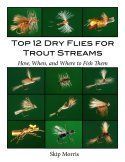 Top 12 Dry Flies for Trout Streams: How, When, and Where to Fish Them
Top 12 Dry Flies for Trout Streams: How, When, and Where to Fish Them
Click here to get more information about
Top 12 Dry Flies for Trout Streams: How, When, and Where to Fish Them (the link to Amazon is at the bottom of the page)...
Top 12 Dry Flies for Trout Streams: How, When, and Where to Fish Them (the link to Amazon is at the bottom of the page)...
Top 12 Nymphs for Trout Streams: How, When, and Where to Fish Them, 2nd Edition, originally published as an e-book only, is now available on Amazon as a paperback...check it out! Click on the links below to go to the information page on Top 12 Nymphs (the link to Amazon is at the bottom of the page...)
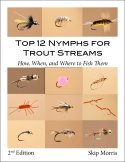 Top 12 Nymphs for Trout Streams: How, When, and Where to Fish Them (2nd Edition)
Top 12 Nymphs for Trout Streams: How, When, and Where to Fish Them (2nd Edition)
Click here to get more information about
Top 12 Nymphs for Trout Streams: How, When, and Where to Fish Them (2nd Edition). . .
Top 12 Nymphs for Trout Streams: How, When, and Where to Fish Them (2nd Edition). . .
Click here to get more information about Skip's e-book,
500 Trout Streams...
500 Trout Streams...
Skip's latest paperback book:
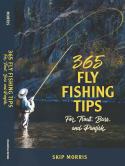 365 Fly Fishing Tips for Trout, Bass, and Panfish
365 Fly Fishing Tips for Trout, Bass, and Panfish
Click here to get more information about Skip's latest book,
365 Tips for Trout, Bass, and Panfish...
365 Tips for Trout, Bass, and Panfish...
Print Skip's chart for FREE:
Skip Morris's Trout-Fly Proportion Chart
Go to Skip Morris's Trout Fly Proportion Chart
Skip's Predator is available to buy...
Skip's ultra-popular Predator—a hit fly for bluegills and other panfishes and largemouth bass (also catches smallmouth bass and trout)—is being tied commercially by the Solitude Fly Company.
The Predator
CLICK HERE to learn more about or to purchase the Predator...
Learn to Tie Skip's Predator
Do you want to tie the Predator?
Tying the Predator
Skip shows you how to tie it on his YouTube Channel link, listed below:
CLICK HERE to see Skip's detailed video on how to tie the Predator...





